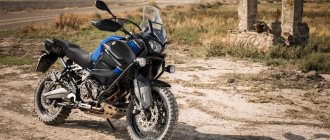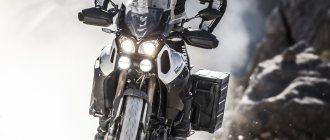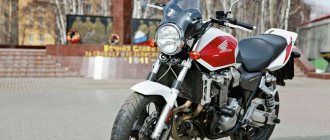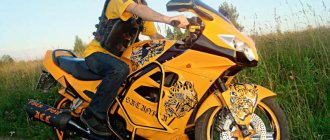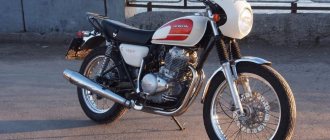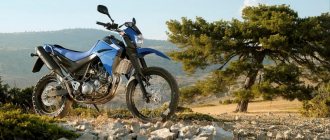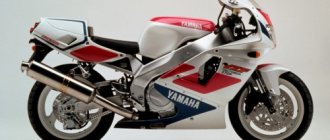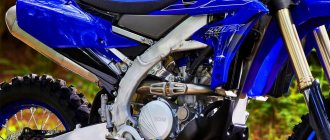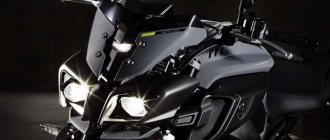- motorcycle model, Yamaha brand,
The Yamaha XTZ750 Super Tenere touring enduro model appeared in 1989 in the image and likeness of the rally racing version of the Yamaha YZE750/850. The motorcycle was aimed at export to European countries (over the years it was also sold in the countries of Oceania and South America) and is not represented in Japan. The model is also called Yamaha Super Tenere 750.
The basis was an in-line 2-cylinder liquid-cooled engine with a volume of 749 cm³, producing up to 69 hp. power and 67 Nm of torque, which was a record for those years and civilian versions of Dual Sport motorcycles. The engine features a dry sump lubrication system and 5 valves per cylinder.
In terms of chassis, the Yamaha XTZ750 Super Tenere has a steel tubular frame, long-travel suspension, disc brakes front and rear, and large spoked wheels.
Other features of the model include a 26-liter fuel tank, a 5-speed gearbox and a 226 kg curb weight.
The junior model Yamaha XTZ660 Tenere was built on the basis of the Super Tenere 750.
1995 was the last year of production of the model, after which it finally left the market, unlike its direct competitor, the Honda XRV750 Africa Twin, which was available until 2000 inclusive. Only in 2010, the Super Tenere series was continued with a completely new model - the Yamaha XT1200Z Super Tenere. Also, the engine concept was not lost, but continued to be widely used and was developed on the TDM and TRX series models.
Bike features
Here are the main features of the Yamaha XTZ 750 Super Tenere:
- the motorcycle was released almost thirty years ago;
- there is enough space on the bike for two, unlike conventionally two-seater models;
- The seating position is comfortable to such an extent that you can drive for a long time without getting tired.
However, the model also has its problems. For example, gasoline consumption here is quite high and amounts to 10 liters per hundred kilometers. Of course, the tank here has a volume of 26 liters, but this is still a significant figure. In general, this motorcycle does not have a long service life, which means it will have to be repaired quite often. That is why you should not drive this car for a long time in wild places where there is nowhere to wait for help.
Test drive YamahaXTZ 750 Super Tenere
Americans love to conduct all sorts of surveys, basing their results on the sublimated opinion of some “average American.” It’s somehow not customary for us to exploit such an image. Nevertheless, it would be interesting to know what kind of transport on two wheels the “average” Ukrainian motorcyclist dreams of, with approximately the following portrait: he uses a “boxer conversion”, loves his country and travel, but is very limited in funds for “abroad” , so he rides within Ukraine (fortunately, we have a lot of unique, historical, and simply interesting places).
But here’s the problem: the quality of our roads is very deplorable, and many places can only be reached by grader or dirt road. The ideal vehicle in this case would be an enduro-tourer, but who in this class is most convenient for riding together, passable, reliable and relatively inexpensive? There are only two long-time rival names that cause serious debate among motorcyclists: the Honda Africa Twin and the Yamaha Super Tenere.
Many readers may be surprised that we took this particular pair of motorcycles for a comparative test. Both models have long been discontinued and represent a rather narrow niche of touring enduros, which is also inhabited by more modern examples. But! Everyone who is “in the know” knows that the “who is better” debate is still raging on the forums, and many copies have already been broken on this issue. We brought together a Honda Africa Twin (factory designation XRV750, modification RD07) and a Yamaha Super Tenere (XTZ750) to try to figure it out for ourselves. By the way, both have earned popular nicknames (Yamaha - “Pimp”, Honda - simply “Africa”), and only legendary motorcycles receive them. Former competitors, the first of which had stunning sporting successes (7 victories in the Paris-Dakar rally), but failed as a commercial model, and the second of which sold superbly, but cannot boast of high-profile sporting victories, went head to head in our test.
Let's start with history. In the early 80s of the last century, the Paris-Dakar off-road rally was gaining momentum in popularity, and many motorcycle manufacturers turned their attention to it. Honda was no exception, announcing the participation of the Honda XLV750R motorcycle, which many consider to be the prototype of “Africa”. It was an original vehicle with large suspension travel, but a low seat, with an engine from an NV750 chopper, weak (by modern standards) brakes, but it had excellent cross-country ability, bright dynamics and... a cardan drive. Despite the excellent driving performance, from 1982 to 1988 the motorcycle was produced in a very small edition of only a few hundred copies and, although it did not fall into the cohort of commercially successful motorcycles, it became a rarity (the cost of a running copy in Europe is 3,000 euros or more!) and served as an impetus for the release of the first modification of the Honda XRV650 Africa Twin. This happened in 1988, and the transition to the higher seat and more powerful XRV750 occurred in 1990. The latest modification, with the index RD07E (it was the one that took part in the test) was produced from 2001 to 2003.
The story of "Pimp" is much shorter. In 1989, immediately after the release of “Africa”, its first modification appeared, as close as possible to the rally prototype. But since 1991, neither the appearance nor the design of the XTZ750 has changed. Technically, the motorcycles are similar - both are two-cylinder, with steel frames, have a chain drive, considerable ground clearance, long-travel suspensions and large tanks. But this is where the similarities end, and the differences begin. The engine from the Yamaha concern looked like a technological miracle in the late eighties - the five-valve cylinder heads of this “in-line” were then a rare solution even in sports. Honda boasted only three valves per cylinder (one intake and two exhaust) and a V-shaped cylinder arrangement. Hence the significant difference in maximum power and crankshaft rotation speed.
But there are no pluses without minuses - the more “sluggish” Honda “vehka” is significantly more economical than the energetic Yamaha engine (by about 20%). The gearboxes, although both are five-speed, are also matched to the engines, have sharply different characters: calmness, small foot travel, clarity and noiselessness of operation in the “Africa” versus the sweep, vagueness and clattering with a crunch of the “Pimp”. The suspensions also differ in torsional rigidity, fork diameters and travel. The front tires are the same size, but the rear tires of the Super Tenere are slightly narrower and higher than the “African” tires. In terms of riding position, the XTZ750 feels leaner, with a narrow seat and tank, while the XRV750 exhibits a little more “hippopotamus-likeness,” although for larger owners this is more of a plus than a minus. If you go through the details, the following picture emerges: the Honda has better wind protection, but it’s more convenient to ride standing up on the Yamaha. Both do not have fuel sensors, but on the “Africa”, with simple manipulations, it is possible to enable the electronic speedometer function in the trip computer and connect the reserve level (fuel remaining) light bulb on the panel. Both motorcycles have fuel pumps, but the V-shape is electric, while the Yamaha straight-line is vacuum-driven. The reliability of both is quite high, but the performance of the latter greatly depends on the condition of the rubber hoses and gaskets, while the XRV750 is able to move without deteriorating dynamics even with a gas pump from... a Honda Dio scooter or a ZAZ stove!
There are also nuances in the design of the controls. For example, on such important levers as the rear brake and gear shift. On the Africa, the gearbox foot folds when dropped, and the rear brake lever is hidden behind the wide protrusion of the aluminum engine protection. On the “Pimp”, both of them bend not only when falling, but also off-road, for example, when driving along ruts.
The service life of both motorcycles is very high and mileage of one hundred thousand kilometers is not some kind of extraordinary figure for them. In addition, both are quite repairable, as they say, almost in “field” conditions. Well, a little about carrying capacity. The XTZ750 Super Tenere is somewhat lighter in weight than the XRV750 Africa Twin, but this lightness is obviously achieved at the expense of the frame, since the latter does not withstand seasonal tourist loads and habitually bursts in several places, forcing the owner to strengthen it. No such exercises were noticed in Honda’s “rogue”. Moreover, both motorcycles are capable of carrying the same payload. As for the dynamic qualities, in real long-distance driving on bad roads (namely, they are intended for driving on them), they are secondary; reliability, ride comfort, stable handling and autonomy come first.
Opinion: Vladislav Sofonov
Height: 180 cm, weight: 75 kg.
Driving experience: 7 years.
With a weight of “over 200 kilograms”, these motorcycles can no longer be simply called “enduro”, but they also cannot be called ordinary road bikes. The rally background of both guarantees that, with sufficient riding experience, both the Africa Twin and the Super Tenere can easily cover thousands of kilometers not only on asphalt, but also on terrain difficult to pass for conventional motorcycles. Therefore, although we only rode along our dirt rural roads, it became clear that it was impossible to test even half the capabilities of these still in demand, extremely interesting, but still gradually disappearing motorcycles.
Both on the road and on light off-road, both motorcycles feel like fish in water, but the difference between them is felt from the first meters. The harsh nature of the Super Tenere engine makes the bike less friendly to beginners. Therefore, in order to cope with it, you should get used to its shortcomings (in particular, the “walking fork”), and it takes a lot of time and effort to understand HOW to control it. On the contrary, when I got on the Africa Twin, I felt like I had already covered hundreds of kilometers on this motorcycle. It operates almost intuitively and does not require as much concentration and attention on the part of the driver.
On the road (and the quality of its surface does not play any role) while driving both motorcycles, you gradually stop paying attention to what is under the wheels. It’s captivating that you don’t even have to stand up on the footrests to move the center of gravity or unload the suspension when hitting a curb. You just need to set the direction. But off-road with a Yamaha you should be more careful. It has virtually no feedback from the road, and therefore it is much more difficult to control the motorcycle. “Pimp”, as he is also called, does not like low revs at all, and therefore it is very uncomfortable to ride it “tight” - the motorcycle twitches all the time. In addition, when driving on a bumpy dirt road with many longitudinal ruts, its rear wheel suddenly began to slip more than once and it was difficult to control this process, while the Africa Twin with its flexible V-shape did not cause such problems.
The motorcycles behaved similarly when braking. Although the brakes of both are well tuned for off-road driving, the Africa Twin's response was more predictable, but both the front and rear wheels of the Super Tenere can suddenly lock up and skid. True, the skid of the rear wheel always remains controlled.
In general, both motorcycles are prone to slight skidding on dirt roads. However, if we were on motorcycles less adapted to off-road, the skids could have been more severe, and with the same consequences. But for the heroes of our test it was just a fun game. Catching the “Africa” from drifts was not particularly difficult even for me, a novice in off-road driving - it itself returned to the intended trajectory as soon as the road under the wheels became more or less smooth. I had to fight with the “Pimp” - it rides steadily “by gullies” if you boldly “open up”, and with my little off-road experience I have not yet acquired this courage.
Just as easily as dirt roads, motorcycles conquer hilly terrain, driving up steep slopes without problems - as long as the rear wheel has a reserve of traction. Due to the considerable height of the seat, it is difficult to make turns off the asphalt on uneven roads on both motorcycles. Even I, who is 180 cm tall, had to constantly stretch my toes to prevent the bike from tilting significantly, which would undoubtedly result in a fall.
Once you hit the road, you begin to appreciate other features of motorcycles. For example, wind protection. Thanks to the high (tuning) windshield, both at 80 and 150 km/h, the wind flow practically does not bother the driver of the Africa Twin. But even if we compare these motorcycles in standard configuration (and I also had a chance to ride a standard Africa Twin), it should be noted that the wind protection on the Super Tenere is still worse. And there is a simple explanation for this - over the long history of the Africa Twin (including its aerodynamics and ergonomics of the driver's seat) they have been improved several times, but the competitor has been produced for less than 8 years and has remained unchanged for all years, moreover, it is higher in price saddle
When riding for a long time at a constant speed, the high-frequency vibrations of the Super Tenere engine are somewhat annoying, which somewhat spoil the overall good impression of riding this motorcycle. In comparison, the moderate pulsation of the Africa Twin's engine is almost imperceptible.
It cannot be said that both motorcycles perfectly “swallow” all the holes and bumps on the asphalt. The driver feels the road and strong bumps transmit dull impacts to the steering wheel and seat. Nevertheless, both bikes, although in different ways, can easily withstand all this, because their suspensions are designed for much more serious obstacles. “Pimp”, when driving fast, is characterized by “swimming” on uneven roads and even short drifts (which adds adrenaline), while “Africa” follows the principle “more speed - less holes!” and behaves at speeds close to maximum, more predictably and stably, I would say, more reliably.
These two motorcycles, which initially seemed very similar to each other, left different impressions of themselves. Of course, both of them are convenient to travel over long distances, on or off poor asphalt, but the opposite characters of the motorcycles impose some restrictions on their owners. A calm, balanced person will feel uncomfortable on the Super Tenere, which constantly requires an aggressive drive. Moreover, in this case “constantly” means EVERY MINUTE. On the contrary, you can always feel relaxed behind the wheel of the Africa Twin. Therefore, we can safely recommend the purchase of a Honda to novice motorcycle tourists who do not have a strong desire to “knead the dirt,” and the Yamaha should appeal to advanced endurists, already as a motorcycle on which you can not only go “far away,” but also, having arrived at the place, grab off-road to places that are difficult to reach for ordinary motorcycles, but interesting.
Extensive touring and off-road capabilities make the Africa Twin and Super Tenere motorcycles that many simply don't want to part with. And, probably, it is for this reason that both of them are so rarely found on sale, and if they are found, then with significant mileage. Which, however, should not frighten real travelers who do not shy away from preparing their bike for the season with their own hands.
Opinion: Alexander Buluy
Height: 190 cm, weight: 85 kg.
Driving experience: 10 years.
Owner of Yamaha XTZ750 Super Tenere.
I bought the “Pimp” last year, and the desire to have it appeared after the publication of an article about this amazing motorcycle in Moto magazine ten years ago. All winter I prepared it for the season. I completely disassembled it, cleaned the tank, welded the frame (it bursts at the base), rebuilt the motor, replaced some rubber bands, bearings and consumables. Now the mileage is a little more than 76 thousand kilometers. I’ve heard a lot about contrasting my Yamaha with the “Africa”, but I’ve never ridden it, but here’s the case... Well, what can I say? Honda is Honda. The motorcycle does not require any getting used to, you just sit on it and go! The box works as clearly as possible, as if it is controlled not by the foot, but by the power of thought (with minimal foot movements), the engine pulls from the very idle speed and this thrust is smooth, there is no “off” or “on” state, as on the Super Tenere . The fork is more rigid and the motor steers easily and clearly, the brakes are quite adequate (especially since there are reinforced brake hoses). The Honda walks confidently on hard ground, whether fast or slow, but on my “Super Tenere” you just have to “push”, as they say, “with all your money”, “crawl” is not to its liking. But it’s more comfortable to ride standing (and for a long time) on the Yamaha - maybe because I put a high handlebar “under myself”, although it’s also more pleasant to squeeze the narrower tank with my knees. “Africa” is very comfortable at maximum speeds (mainly in terms of wind protection), but overall it is a calmer motorcycle.
But I like the brightness of my motorcycle, its wayward character and the fact that it always forces you to be “on your toes” and does not allow you to relax. It is for “advanced” riders!
Something about technology...
SuperTenere is a good car, both for traveling and for off-road driving (more universal), but with special features.
First of all, this is oil consumption. The cylinder heads are ten-valve, versus six-valve in the Africa. As valve seals age, they allow more oil into the cylinders. A working engine “eats” from 200-500 milliliters of oil per thousand kilometers. If the consumption is more than 0.5 liters per thousand kilometers, you need to change the valve seals, and maybe the bushings at the same time. There are NO low pressure or oil level indicators on the XTZ750. Only the dipstick is in the oil tank under the right rear trim, which takes a long time to get to.
The second is an outdated design. The cylinder block is liner, which implies the need for a break-in process for the new engine. Often there are incorrectly run-in units with broken cylinder geometry and reduced compression, which again causes increased oil consumption. This can be “treated” by boring, but it takes a long time and is expensive.
Third, the poor condition of the rear wheel bearings, which is directly related to the condition of the rear axle seals, and this is often deplorable, so it is better to immediately replace worn parts.
Fourth, the frame, which, if it is not immediately strengthened with welded overlay plates (by completely disassembling the motorcycle), bursts on our roads with enviable regularity.
In addition, when purchasing, you must take into account that the Japanese (and often “Pimp” is brought from Japan) rarely and poorly take care of motorcycles. Even the oil may never be changed. With Europeans this problem does not exist; almost all motorcycles have a service history and replaced parts. And, nevertheless, the latest motorcycles that are now on the market are produced in 1996-1997. Hence the need to replace the “original” tires. Even if they have worn out just a little, their aging from contact with air and sun will lead to accelerated wear in the future. It should be noted that the condition of bikes from Europe is better than Japanese ones.
Africa Twin is the most comfortable long-range vehicle with the highest degree of reliability. The best condition is found on motorcycles from Europe (except for the UK, specimens from there are heavily corroded), the “Japanese” ones are a little less polished, but their mileage is significantly less. No special “factory defects” were noticed on the “Africa”. There are failures of the electric fuel pump relay (due to overheating), but even without it the motorcycle can move. After 60,000 km, the damper springs in the clutch mechanism may weaken (an extraneous sound appears), but it is difficult to call this a defect, since it does not cause any problems, until the clutch basket is replaced AFTER 100,000 km... After a run of 45-50 thousand kilometers, you should pay attention to the condition tapered bearings of the steering column and drive sprocket shaft. That's probably all...
Text: Valera DRIVE
(height 186 cm, weight 125 kg, driving experience 29 years)
Photo: Andrey Shlenchak
Motorcycles for testing were provided by the ProMoto motorcycle dealership and Alexander Buluy.
Engine
The engine here is in-line and has two cylinders. Its effective volume reaches 749 cm³. This four-stroke unit produces 68 Nm of peak torque and 69.3 hp. maximum power. The maximum speed of the motorcycle is 192 km/h. However, already at a speed of 150 km/h the bike is not very stable.
Dimensions and weight
The weight of this bike without fuel is 203 kg. The XTZ 750 Super Tenere has a seat height of 865 mm, a wheelbase of 1505 mm, an overall height of 1355 mm, a width of 815 mm, and a length of 2285 mm. Such dimensions are very typical for touring enduros, among which, by the way, there is no diversity in this regard.
Brief history of the model
1989 - official start of production. Model: Yamaha Super Tenere 750 (Europe). Factory designation: 3LD1, 3LD2, 3SC1, 3TD1.
1990 - The model undergoes minor changes affecting the design of the passenger footrests and brake pedal, as well as technical changes in the electrical system. Model: Yamaha Super Tenere 750 (Europe, Oceania). Factory designation: 3LD3, 3SC2, 3TD2, 3VA1, 3WM1, 3WY1.
1991 - no significant changes. Model: Yamaha Super Tenere 750 (Europe, Oceania). Factory designation: 3LD4, 3SC3, 3TD3, 3VA2, 3WM2, 3WY2.
1992 - no significant changes. Model: Yamaha Super Tenere 750 (Europe). Factory designation: 3LD5, 3SC4, 3TD3, 3WM3.
1993 - no significant changes. Model: Yamaha Super Tenere 750 (Europe). Factory designation: 3LD5, 3LD6, 3SC5, 3TD4, 3TD5, 3WM4.
1994 - no significant changes. Model: Yamaha Super Tenere 750 (Europe). Factory designation: 3LD7, 3SC6, 3TD6.
1995 is the last year of production. Model: Yamaha Super Tenere 750 (Europe, South America). Factory designation: 3LD8, 3SC7, 3TD7, 4PY1.
Chassis and brakes
The exterior of the bike is definitely its positive feature. There is nothing to complain about here, because the steel frame in combination with the characteristic steering wheel, wind protection and spoked wheels looks great. Yes, the motorcycle cannot be called flashy, but beauty does not always have to catch the eye.
A progressive monoshock serves as the rear suspension, and a telescopic fork serves as the front suspension. The XTZ 750 Super Tenere brakes thanks to a 245 mm rear disc with a single-piston caliper and a pair of front discs of the same diameter, complete with two-piston calipers.
